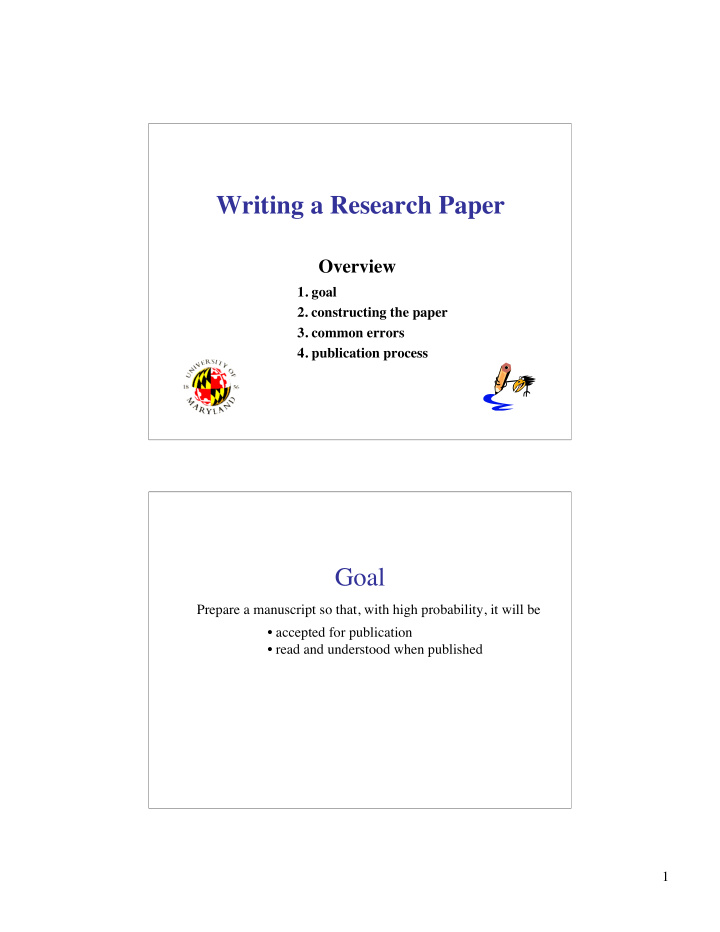



Writing a Research Paper Overview 1. goal 2. constructing the paper 3. common errors 4. publication process Goal Prepare a manuscript so that, with high probability, it will be • accepted for publication • read and understood when published 1
Why should you care? • you will be judged based on your publications • makes acceptance of papers more likely • writing is very difficult for most of us Many papers are poorly written. The good news is that technical writing is a learnable skill. The Process of Writing do write Traditional View research paper do write Reality research paper Writing the paper can - help develop and clarify your ideas - force you to be clear and focused - predict anticipated interesting results - promote collaboration with others 2
Assumptions • already have results • specific journal selected • structure and content • pirates’ code of honor Top Level Structure • Title Page • Introduction Whatever they are • Methods called, there are four • Results critical components. • Discussion • References • Appendices 3
Introduction • key questions to answer … What problem was studied, and why? What is your primary contribution? • you are teaching the reader your idea and why it is important • explicitly state your key idea • conveying the intuition is primary • examine your assumptions about the reader Organization of the Introduction 1. Context and Background 2. Make the Problem Clear • explicitly state the problem • explain why it is important, interesting • make it clear the problem is unsolved • briefly relate to past work 3. Explain Your Contributions • explicitly state your solution or key idea • describe how it works, what questions it answers • explain how it differs from past solutions • identify relevant hypothesis • explicitly state what you show (be specific) 4. Overview? (integrate in above) 4
Use Concrete Examples! • clarify new ideas, especially if abstract • choose examples carefully - illustrate key ideas - but simple enough to understand • running examples can be economical Clarify new concepts by presenting them in more than one way. e.g., picture + text e.g., equation + picture e.g., text + example Methods • key question to answer … How was the problem studied? • method/model/algorithm • experimental procedures • analysis methodology 5
Results • key question to answer … What were the findings? • measurements, analysis, theorems, etc. • results presented should provide evidence for each contribution* • check this is so against the introduction • state each claim first then provide supporting evidence, not vice versa * top-down organization Visualizing Information Heuristic for figures vs. tables … figures to show trends/differences, tables just for exact values 6
Discussion • key question to answer … What do findings mean? • how to organize … - summary + limitations - include your conclusions - relate to past work + significance - directions for future research Title Page • importance Title • good qualities Authors • common mistakes Affiliations Date • importance Abstract • one paragraph • summary • write last Key Words • common mistake? Contact Info. 7
Common Mistake: Omitting Results The abstract is a summary, not an introduction. Always include something like “Here we show …” “Previous computational models of self-replication using cellular automata have been manually designed, problem a difficult and time-consuming process. We show here how genetic algorithms can be applied to discover rules governing self-replicating structures. … Experimental yields of discovered self-replicating structures are results statistically significant, and the structures compared favorably in terms of simplicity with those generated manually in the past, but differed in unexpected ways. …” J. Lohn, J. Reggia, IEEE Trans. Evol. Comp ., 3, 1997, 165-178. Other Material • acknowledgements • references • appendices • online supplemental material 8
Common Mistakes - writing at the wrong level - excessive background material - not explicitly explaining innovation - overstating significance of your work - failure to give credit to others - insulting the reviewer - describing a system/implementation - no explicit conclusions Technical Errors • material put into wrong section • no results given in abstract • including Background after Introduction • omit key methodology info. (reproducible) • recapitulating journey in obtaining results • tabular rather than figure presentation • inadequate figure captions • giving tables captions • failure to use spell checker • royal we, passive voice, forward refs. 9
Recurring Issues • scope of material • journal vs. conference • which one • authorship - who - order • permissions • conflict of interest • multiple submissions • pre-submission critiques Publication Process • start early … very early • always have your manuscript read by others (colleagues, experts, naïve readers) • clarify comments that you want Common error: starting a paper too late for deadline 10
Submission Procedure • journal selection • suggest/exclude reviewers? Science , 2005 Review and Publication Process • review process • outcome possibilities: 1. reject 2. revise and resubmit - cover letter - common mistake 3. accept • value reviewer comments as suggestions for improvement • this is very difficult but very important 11
Citation Statistics • increasingly used to measure researcher “impact” • caution: - name confusions, inaccurate numbers, etc. - extraneous influences (length, web posting, etc.) http://arxiv.org/abs/0809.0692 References and Further Information M. Alley, The Craft of Scientific Writing , Springer, 1997. M. Davis & G. Fry, Scientific Papers and Presentations , 1996. R. Day, How to Write and Publish a Scientific Paper . Oryx, 1998. J. Gibaldi, MLA Handbook for Writers of Research Papers . MLA, 1999. B. Luey, Handbook for Academic Authors , Cambridge Univ. Press, 1990. L. Gillman, Writing Mathematics Well , MAA, 1987. E. Tufte, Visual Display of Quantitative Information , Graphics, 1983. W. Strunk & E. White, The Elements of Style , Allyn and Bacon, 2000. 12
Recommend
More recommend